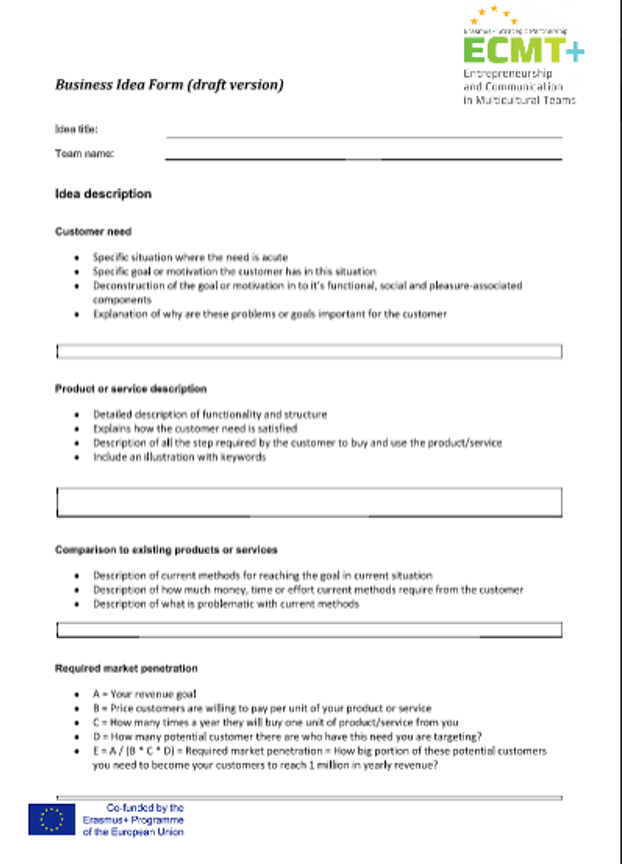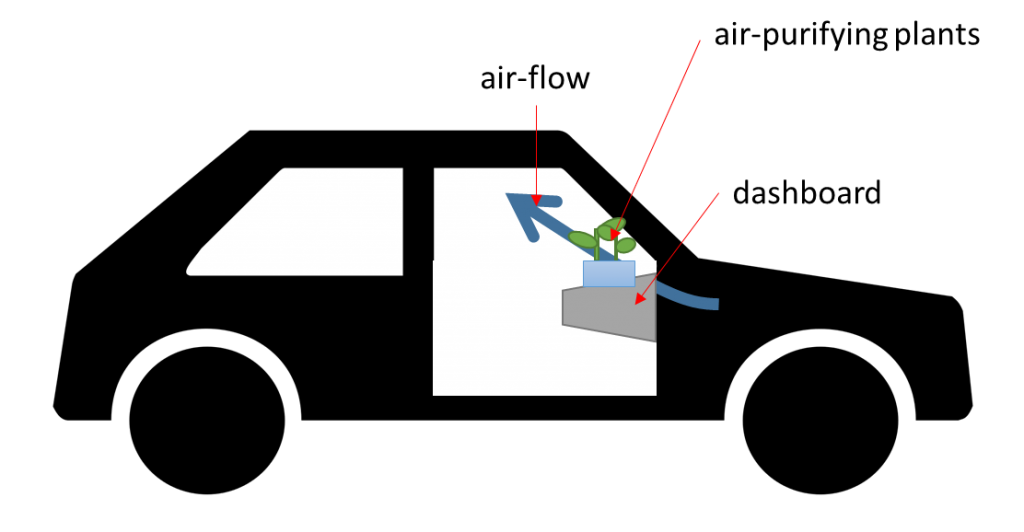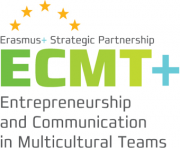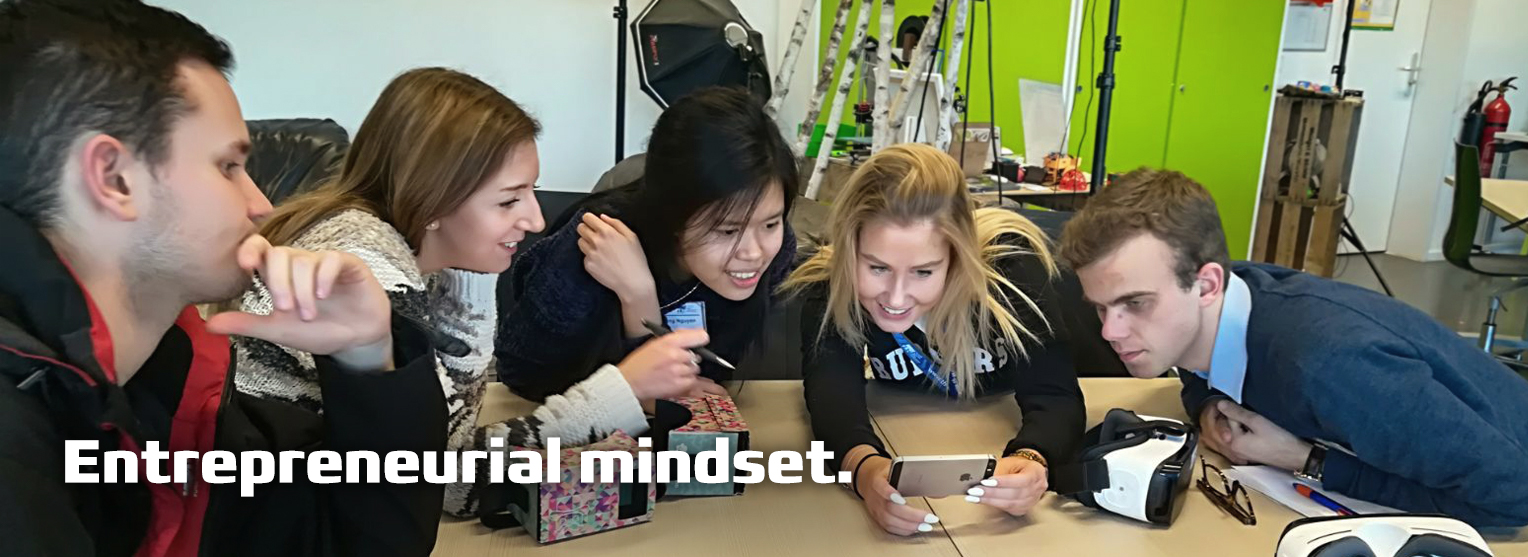by Heikki Immonen, Karelia University of Applied Sciences
Welcome ECMT+ Blended Module!
By following this guide you will learn what is a business idea and how to evaluate them.
You can do all the following steps by using this business idea form

Step 1: What is your product about?
You should have an idea. Start by describing the details. This description should contain the following elements:
• Detailed description of functionality and structure
• Explains how the customer need is satisfied by the product
• Description of all the step required by the customer to buy and use the product/service
Imagining the details of the product and how it will be used, will reveal a lot of ways for improving it. If you cannot clearly describe how your product will satisfy the need of your customer, it’s possible that the idea is not good after all. Also, there needs to be a convenient way for your customer to buy your product. If this way is in harmony with situation, the better. For example, a kiosk selling umbrellas at entrance of a subway station on a rainy day would nicely fit with the customer need.
Example
Grassboard
Grassboard is a wide and flat pot, which is installed on top of the dashboard inside a car. Durable air-purifying plants species are growing in the pot. These plants capture the impurities. Plants get all of the light they need through the windshield. Driver needs to water the plants once every week. Small (sun powered) fans direct the air flow through the Grassboard.
Process:
1. Customer orders the Grassboard online,
2. installs it,
3. waters the growing medium, which includes the seeds and
4. waits for few weeks for the plants to starts growing,
5. water is added once a week.

Step 2: Why and when are customers needing your product?
This description should contain the following elements:
• Specific situation where the need is acute
• Specific goal or motivation the customer has in this situation
• Deconstruction of the goal or motivation in to it’s functional, social and pleasure-associated components
• Explanation of why are these problems or goals important for the customer
We always use products and service in specific situation for specific gains. What is this situation and this gain for your product? If you cannot define the reason why your customer would buy your product and when it would be utilized, there is no way you can improve your product in a way that it becomes more desirable for your customer. When you specify the need, you are able to estimate how big the business opportunity is i.e. how many customers you would potentially have.
Remember, some products are mostly functional i.e. they have some practical benefit. For example pen allows you create text and drawings. Some product mostly focus on social and identity benefits. In a traffic, Ferrari won’t get you any faster from place A to B, but for some social status benefits can be considerable. Some products are there to satisfy pleasure-associated needs: eating chocolate produces pleasure, while pain-killers reduce pain.
Example
Many urban people spend easily at least 2 hours of their time in their cars. Because of traffic jams and exhaust fumes from other cars, the air quality inside a car is poor. This produces long-term health consequences, as a result of people inhaling the impurities. We are especially targeting mothers (and fathers) who take their children to day care or school on daily basis. They would spend at least 1,5 hours per day in the traffic with children.
Mothers don’t want their children to get exposed to pollution because of the long-term health issues. The need is mostly functional, but maybe mothers also want to be seen by their peers as good mothers who actively demonstrating that they care.
Step 3: Required Market Penetration
Now that you have defined your product and the customer need it's targeting, you should do your first evaluative step. You need to define your Required Market Penetration
• A = Your revenue goal
• B = Price customers are willing to pay per unit of your product or service
• C = How many times a year they will buy one unit of product/service from you
• D = How many potential customer there are who have this need you are targeting?
• E = A / (B * C * D) = Required market penetration = How big portion of these potential customers you need to become your customers to reach 1 million in yearly revenue?
You don’t want to end up developing a good product to a market that doesn’t have room for you to grow. Developing a 50 € product for professional penguin photographer who need to buy the product only once, is probably not a good idea. How many professional penguin photographers there are? Ten? That would mean your total market size would be 500 €. You should define how many customers you need in order to reach your business goals. If this number is more than 100 % of the potential customers, than your idea cannot work even in theory. The smaller the percentage, the better.
Writing these numbers offers a great basis for doing further research and testing. Remember, the number of potential customers (D) should be based on the number of people having the exact need you’ve defined earlier.
Example
A (revenue goal): 1 000 000 €
B (price customers are willing to pay): 50 €
C (purchase frequency): 0,2
D (number of potential customers): 5 000 000 (mothers who spend at least 1,5 hours per day in the traffic with their children)
E (required market penetration: 2 % = 100 000 customers
Step 4: Evaluating the idea by comparing it to existing products or services
Is the need real? How much are your customers willing to pay? This step will provide you with some preliminary answers.
• Description of current methods for reaching the goal in current situation
• Description of how much money, time or effort current methods require from the customer
• Description of what is problematic with current methods
If you cannot think of any other ways for your customer to satisfy the need, it is likely that the need is not real. If you look in to how much customers are spending on these existing solutions, you get a sense of how important the need is for them. If your customers are already paying or investing a lot of time and effort to solve the need, you have the best kind of evidence that the need is real. The better you understand the need and your customer, the better you are able to define what are the criteria your customer is using to rate different competing offerings. These criteria will allow you to see where you can be better than existing methods.
Example
Current ways to deal with air pollution are facemasks, advanced air-filtering technology in new cars, specific electrics air-filter devices and avoidance of rush hours. People who worry about air-pollution can spend between 5 € (cheapest face masks)– 200 € (electronic air purifiers). Face masks are not comfortable and electronic purifiers can be expensive and feel overtly technical.
Step 5: Cost Structure
Did you clear step 4 or did you have adjust your idea? In this step you think more deeply what is required to get customers and to produce and deliver your product to those customers.
• Variable costs of your business at your revenue goal
• Fixed cost of your business at your revenue goal
The customer need might be real, the product idea a good one, but it ends up being too expensive to manufacture and deliver. A personal assistant costing only 10 € a day might be something everybody would appreciate. It would be a guaranteed hit! However, in practice with minimum salary the expenses for an assistant for a one full day would start from 100 € or higher.
Building a house requires materials and labour. These cost money. The more houses you sell, the more you have to pay for labour and construction materials. These are called variable costs. Your construction business also has a website, office-space and people working as salespersons and as administrative staff. These are fixed costs, because you have to pay to these people even regardless of how many houses you sell. Simple principle: when you start a business, try to keep your fixed costs to a minimum.
Sketching out a rough cost structure creates the base for doing more detailed financial calculations later in your business idea development process.
Example
Variable costs:
- Pot, growing medium, plant seeds.
- Packaging
- Postage
Fixed costs:
- Online store
- Online advertisement
- Production
- Delivery
- Customer relationships
Step 6: Team Description
Do you have the means for making your idea happen?
• Name of each team member
• Role and tasks in the team
• Description how team member’s background/experience/skills allow her to do a good job
If you and your team doesn’t have the relevant skills and expertise to start working on the business idea, it will not go anywhere. You can create only something that you can create. That’s why it’s very important to align your business idea with your resources and skills.
Example
Terezija Sauveterre
Role: team manager, financial issues
Supporting experience: She is the chairperson of the university’s domino club. She studies economics (information economics) and has used to working with many kinds of people as an interpreter and translator.
Nora Dragić
Role: product designer
Supporting experience: She studies organic chemistry and has focused on air purification issues in her thesis. Also, during her time as a civil engineer trainee she became familiar about the scope and seriousness of the air pollution problem. Since childhood, she has been a fan of inventions and the history of inventions. She is a member of the local technology club, which allows her to work on her own prototypes.
Rahul Tennison
Role: sales, marketing
Supporting experience: Rahul has studied dancing and has worked as the customer service representative of the theatre where his dance company would often perform. The theatre was established in to an old porcelain factory. Thus porcelain teapots (and organic tea) and plates were on sale in theatre’s souvenir shop where Rahul also worked part-time. As a result, he is used to doing business with female customer segment.
Step 7: Motivation
Are you motivated enough?
• Description each team member’s personal motivation to be involved in this project.
• Number of hours each team member is willing and able to invest to project in the next 6 months.
If the business idea and its development is not aligned with the plans and goals of each member, it’s unlikely the project will move forward.
Example
Terezija Sauveterre: Terezija’s biggest motivation is gain experience as start-up business manager. The possibility of complete financial freedom is not a bad motivator either. 10 hours per week.
Nora Dragić: Desire to build create a product that makes a difference, important experience. 20 hours per week. She loves building things.
Rahul Tennison: Rahul understands the importance of solving the air pollution issue. He also would like to broaden his expertise beyond the culture and art sectors. 5 hours a week.
Step 8: List of Uncertainties
Now you've got your idea define and have done some simple evaluation. It's time to start planning for some more serious test.
• List of uncertainties and unanswered questions related to any part of the business idea or team
• List is in prioritized order with most urgent uncertainties on top
• There are minimum 5 uncertainties on the list
Your business idea might be work or then it might not. Your job is to get from big uncertainty towards certainty. You start this by honestly and humbly listing and prioritizing the uncertainties associated with your business idea. There are a lot of them. The ones that are most crucial to your idea should be placed on top of the list.
Example
Key uncertainties at moment for the Grassboard are:
1. Is it legally allowed to place any objects on the Grassboard?
2. Are there actually 5 million mothers spending at least 1,5 hours in the traffic with their kids?
3. How much plants are needed to actually purify the air inside a car?
4. How many mothers are actually worried about the air they and their children breathe?
5. What kinds of temperature fluctuations a car experiences?
6. Can we find plant species that grow well inside cars, but are also good air purifiers?
7. Can we design a universal solution that works in all kinds of car models?
8. Can we build and generate profit from the product if it costs 50 €?
9. How much water the plants need per week?
10. Is online ads the best way to reach our customers?
Step 9: Testing plan
What happens next?
• a simple testing plan i.e. validation plan, is presented for all uncertainties
What are the cheapest and quickest ways of testing each listed uncertainty? If there would be no uncertainties, then doing tests would be waste of time and money. However, If there is uncertainty, building everything without small tests will likely result in waste of time and money.
Example
Testing plan for the uncertainties:
Uncertainties 1.-3.:
Uncertainties 1. to 3. will be cleared by doing web search and probably making some phone calls if needed. Based on existing research we should be able to find answers to these questions.
Uncertainty 4. (also uncertainty 10.):
Uncertainty 4. is first studied by looking in to existing research and some online discussion forums. If there isn’t good enough information available, an online questionnaire targeting mother in high pollution urban areas is needed. One possibility would be to create pre-order ads and a landing page. This option would also help determine the status of uncertainty 10.
Uncertainty 5.:
Web search is the first choice for uncertainty 5.
Uncertainty 6.:
Given the results from step 3, we are able to asses, which plants would work best (uncertainty 6.) for our solution.
Uncertainties 7. and 8.:
Uncertainties 7. and 8. require us to start doing scale-models, mockups and other prototyping activities. Uncertainty 8. also needs some web search about manufacturing costs.
Uncertainty 9.:
This would be best studied by first doing the test inside one of our apartments and then using a very rough prototype in a volunteer’s car.
References
Anthony, S. D. (2014). The first mile: a launch manual for getting great ideas into the market. Harvard Business Review Press.
Christensen, C. M., Dillon, K., Hall, T., & Duncan, D. S. (2016). Competing against luck: The story of innovation and customer choice. Harper Business.
Ries, E. (2011). The lean startup: How today's entrepreneurs use continuous innovation to create radically successful businesses. Crown Books.
Smart, G., & Street, R. (2008). Who: The A method for hiring. Ballantine Books.





